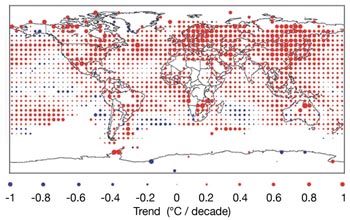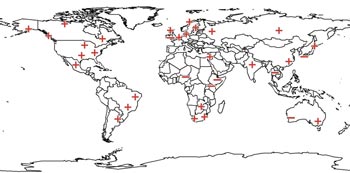Introduction - Canada in an International Context
1.1 PURPOSE OF CHAPTER
Climate is changing the world's economy and environment. In a world of increasing interactions between citizens and companies of different countries through travel and trade, and with migration of species and transborder threats to ecosystems, the impacts of climate change are not confined by national borders. Key issues for Canada include changes in trade, immigration and tourism patterns; transborder effects on water, health and air pollution; increasing stresses over resources; and the need for international responses to more frequent and larger disasters. In a number of cases, stresses brought about by 'economic globalization' will be exacerbated by climate change.
Northern circumpolar countries are already experiencing major climate change effects, and adaptation by one nation can have consequences for others. In all three oceans bordering Canada, changes in currents and distribution of fish, more severe winter storms, and rising water temperatures and levels will trigger actions by other countries that could have significant effects in Canada.
In short, climate change impacts and adaptation in other countries may have profound effects on Canada. This chapter is an initial attempt to identify some key issues for Canada from an international perspective and discuss possible responses.
1.2 INTERNATIONAL CLIMATE CHANGE TRENDS AND PROJECTIONS
What climate changes have other countries experienced in recent decades, and what are the likely changes over the next four or five decades? Much of the information here is drawn from the assessment reports of the Intergovernmental Panel on Climate Change (IPCC) and from scientific publications since 2000.
Temperature

FIGURE 1: Annual temperature trends (°C/decade), 1976-2000. Red indicates warming trend, blue indicates cooling trend, and the size of circles is proportional to the magnitude of change (Folland et al., 2001).
Global mean temperature has increased about 0.74°C during the past century, with the rate of temperature rise being much greater after 1979 (Intergovernmental Panel on Climate Change, 2007a). Large departures from this average have been experienced in various regions, as illustrated in Figure 1. By 2050, the range of expected warming (1.3 -1.7°C relative to 1980-1999) shows limited sensitivity to the choice of emission scenarios (Intergovernmental Panel on Climate Change, 2007a). Again, large regional departures from these mean temperature values are expected. Evaporation rates will generally increase as air and especially water temperatures rise.
Precipitation

FIGURE 2: Regions of disproportionate changes in heavy and very heavy precipitation. Thresholds used to define heavy and very heavy precipitation vary by season and region (modified from Groisman et al.,2005).
Globally averaged precipitation since the 1960s has remained largely unchanged (Gruber and Levizzani, 2006), although other estimates suggest an average increase of about 2% over land areas (Folland et al., 2001). Increases and decreases in annual precipitation for the past 3 to 4 decades are regionally variable (Groisman et al., 2005). Regions of declining rainfall include much of the Mediterranean basin and northern Sahara, southern Africa and Argentina, parts of the Middle East, northern Mexico and the southwestern United States. Global climate model projections of precipitation changes during the next few decades are somewhat inconsistent, although they suggest a continuation of the patterns observed since 1970. In many locations, it may be most useful to simply extrapolate the trends of the past few decades. In most regions, observed changes in heavy and very heavy precipitation are more significant than changes in mean precipitation (Groisman et al., 2005). The global distribution of trends in heavy precipitation is shown in Figure 2. Climate models project a continued increase in the intensity of rainfall events that have been observed in many parts of the world (e.g. Alexander et al., 2006).
Sea-Level Rise and Oceans
Global mean sea level has increased about 18 cm during the past century, and at an accelerating rate of 3 mm/a since 1992. The further rise projected by the Intergovernmental Panel on Climate Change (2007a) for the years 2090 -2099 relative to 1980-1999 ranges from 18 to 59 cm. However, these results do not include the full effect of potential changes in ice-sheet flow or breakup in Greenland and Antarctica (Intergovernmental Panel on Climate Change, 2007a). From 2001 to 2004, glacier melt contributed about 1 mm/a to sea-level rise and accounted for 20 to 30% of the total rise from 1991 to 2004 (Kaser et al., 2006). Many low-lying coastal plains and small island states are vulnerable to the rising seas, especially in storm conditions.
Globally averaged sea-surface temperatures have risen 0.4°C since 1970 and 0.6°C during the past century (Rayner et al., 2003; Pierce et al., 2006). The anthropogenic (greenhouse gas) warming signal is clearly evident in all ocean basins: Indian, Pacific, Atlantic and Arctic (Pierce et al., 2006). This has also contributed to sea-level rise through thermal expansion. Increased acidity of ocean surface layers, due to more CO2 absorption, has also been detected and is projected to cause further reductions in pH of between 0.14 and 0.35 units by 2100 (Intergovernmental Panel on Climate Change, 2007a).
Extreme Events
Severe winter storms in the Northern Hemisphere have increased in intensity in some regions (McCabe et al., 2001), a trend that is projected to continue (Lambert, 1996; Lambert and Fyfe, 2006). This increase, combined with higher sea level, will lead to greater storm surges, shore erosion and flooding effects in many coastal areas.
The average annual number of tropical cyclones (hurricanes) has not changed, but intensities are increasing, with a greater proportion of category 4 and 5 storms observed since 1970 (Emmanuel, 2005; Webster et al., 2005). Models suggest that intensification is related to sea-surface temperatures and will continue in the future (Knutson and Tuleya, 2004).
Changes in other extreme events have been assessed by the Intergovernmental Panel on Climate Change (2001a, 2007a), and include increased frequency of high-intensity rainfall in many areas, more frequent and intense droughts in midcontinental and low-latitude regions, and an increase in areas subject to drought (Intergovernmental Panel on Climate Change, 2007a)
Other Trends and Impacts
- Permafrostis thawing in North America, Europe and Asia, a trend that will continue or accelerate, with resulting impacts on hydrology, wildlife and the built-environment (Intergovernmental Panel on Climate Change, 2001b; Arctic Climate Impact Assessment, 2004).
- Snow coverin the Northern Hemisphere at the time of spring melt (March-April) continues to decline, with more melting generally occurring during the winter months (Mote et al., 2005). Less flow in the summer and autumn dry seasons is affecting, and will continue to affect, water availability for irrigation and other uses.
- Very dry areashave increased globally in extent, from 12 to 30% of total landmass since 1970 (Dai et al., 2004). The Palmer Drought Severity Index (Figure 3) has shown widespread drying trends over large regions, including much of Africa. Increasing drought also characterizes many important food-producing regions, including the Great Plains of North America.
- Wave heights have increased by up to 1 cm/decade (1950-2002) in much of the North Pacific and North Atlantic, in the Mediterranean and along the east coast of South America (Gulev and Grigorieva, 2004), with consequent effects on shipping and drilling platforms. Recent studies indicate that these increases are expected to continue (Caires et al., 2006).
- Greater variability in the summer monsoon rainfall is likely causing more severe drought and flood events in India and southeast Asia (Lal et al., 2001). Monsoonal rainfall in Mexico and the northern Caribbean, the sub-Saharan grasslands and southeastern Africa has declined since 1975 (Chen et al., 2004).
- Reduced lake-ice cover, earlier spring algal blooms, higher spring surface-water temperatures and earlier stratification of lakes (by two to four weeks) have been observed in Europe and other temperate regions (Mortsch et al., 2003).
-
Phenological events for land species are also now earlier in the year by 5 to 14 days, providing a longer growing season in the Northern Hemisphere since the 1950s for various plants and trees. Global terrestrial net primary production has increased 6% between 1982 and 1999, according to satellite measurements, especially over northern temperate latitudes (Nemani et al., 2003).

FIGURE 3: "The most important spatial pattern (top) of the monthly Palmer Drought Severity Index (PDSI) for 1900 to 2002. The PDSI is a prominent index of drought and measures the cumulative deficit (relative to local mean conditions) in surface land moisture by incorporating previous precipitation and estimates of moisture drawn into the atmosphere (based on atmospheric temperatures) into a hydrological accounting system. The lower panel shows how the sign and strength of this pattern has changed since 1900. Red and orange areas are drier (wetter) than average and blue and green areas are wetter (drier) than average when the values shown in the lower plot are positive (negative). The smooth black curve shows decadal variations. The time series approximately corresponds to a trend, and this pattern and its variations account for 67% of the linear trend of PDSI from 1900 to 2002 over the global land area. It therefore features widespread increasing African drought, especially in the Sahel, for instance. Note also the wetter areas, especially in eastern North and South America and northern Eurasia." (Trenberth et al., 2007 p. 263, which was adapted from Dai et al. 2004).
- More heat waves have been observed over most land areas. In addition to having major health implications and causing premature deaths (e.g. in Europe during the summer of 2003), heat waves can also result in agricultural losses, changes in ecosystems and wildlife, and increased energy demand for cooling. On the other hand, continuation of the current trend of fewer very cold days (Alexander et al., 2006) will reduce heating needs and the number of cold-related injuries and deaths.
- Arctic sea-ice annual area has decreased significantly (7.4%; Johannessen et al., 2004) in the 25 years prior to 2002. The year 2005 had the least Arctic sea-ice extent in September since satellite observations began in 1979. These changes, projected to continue, could accelerate the use of shipping channels and exploration for oil, gas and minerals, but have adverse effects on wildlife and hunting activities of Arctic people (see Section 3.3 of this chapter, as well as Chapter 3).
- Widespread retreat of glaciers is underway in the western Americas, the Alps and most of the Himalayas, threatening key water supplies in South American countries (Mark and Seltzer, 2003) and elsewhere. Total ice loss from the Greenland Ice Sheet in 2005 was double the 1996 value (Rignot and Kanagaratnam, 2006), contributing to freshening of northern North Atlantic waters, although the central ice cap has either remained unchanged or perhaps thickened due to greater snowfall. The freshening of the northern extension of the Gulf Stream may be weakening thermohaline (meridional overturning) circulation, including the Gulf Stream. If this persists as predicted, it would result in less warming than would otherwise occur in Europe and northeastern North America (Intergovernmental Panel on Climate Change, 2007a).
Based on these trends and impacts, as well as consideration of adaptive capacity, the regions assessed as being most vulnerable to the risks associated with climate change and sea-level rise are the Arctic, sub-Saharan Africa, small islands and Asian megadeltas (Adger et al., 2007). Nevertheless, all regions have vulnerable areas, communities and sectors (Adger et al., 2007).
Page details
- Date modified: